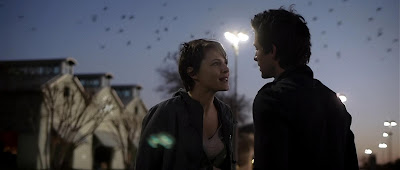In 2004, former engineer Shane Carruth released his debut film - a low-budget time travel movie called Primer - which he wrote, produced, edited, composed music for, starred in, and directed. Despite its incredibly dense technical dialogue and rough-around-the-edges appearance the film won the Grand Jury Prize at Sundance and earned a cult following, turning Carruth into something of a rock star for cinephiles. Carruth has attempted to get a few projects off the ground since then, but has remained quiet...until now. His second feature, Upstream Color, premiered at Sundance earlier this year and comes out in limited release on April 5th, 2013.
Upstream Color
Writer/Director: Shane Carruth
Starring: Shane Carruth, Amy Seimetz, Andrew Sensenig
Like Primer before it, Upstream Color is the kind of movie that dares you to figure out what it's trying to do. Compared to most other films, it's almost totally inaccessible - but Carruth is the kind of guy who doesn't give a sh*t if you can follow the story or not. He refuses to dumb things down for his audience, demanding that you pay attention to every frame and decipher his non-stop barrage of symbolism. Curious and more adventurous audience members might find this method of storytelling engaging, but the same mystery that will be such a draw for hardcore film lovers will be far too much for most viewers to handle. When the plot itself is shrouded in a haze of fractured narrative fragments, it's obvious that the filmmaker isn't setting out to make a movie for everyone. It took me two viewings before I could even understand the basics of what actually happens in this movie, but the discovery is worth a second look because of the film's rich themes and vivid imagery.
At its core, Upstream is a love story. An unnamed thief, who has harnessed the power of a rare breed of worms and distilling them into a mind control drug, captures a woman named Kris (Amy Seimetz) and puts her under his spell. He commands her to empty all of her bank accounts, write out pages from Walden novels by hand, and make paper chains out of the hand-written pages before he eventually abandons her. Another man, known as the Sampler (Andrew Sensenig), records sounds from nature with a microphone and manipulates them into a chilling distortion which he plays over loudspeakers at his pig farm. Following the sounds, Kris shows up and the man transfers the worms from her body into that of a pig, which he then releases into his compound.
Waking up in a van on the side of the road and completely unaware of her actions while she was hypnotized, Kris slowly puts her life back together, meeting and falling for Jeff (Shane Carruth), a man with whom she shares a strange and inexplicable connection. Strange connections seem to be the currency of Upstream Color, whether it's the constant cross-cutting between Kris and Jeff to show their connectivity, juxtaposing shots of the couple with shots of pigs, the confused memories the two lovers seem to share, or the weird repetition that Carruth creates by staging the couple at two different places at seemingly the same time. It's a bizarre movie, to be sure, and the imagery is often beautiful and dreamlike, but I just couldn't connect with it the way many of my colleagues did because I was too busy scrambling to put all of the pieces together. (It doesn't help that the thief looks a lot like Jeff, making things even more confusing.) Carruth wants you to have an emotional response to his story, but I spent so much time reeling that I could never fully invest in the characters.
Upstream often pummels the audience with its sound design, and the initial reaction is to call it "good" just because it's recognizable. Though detractors may pinpoint this overuse of sound as a film school gimmick, Carruth actually does some pretty impressive work in this category. The movie occasionally gets loud, but there's always a reason for it that's tied to the narrative. There's even a sequence that goes on for probably ten minutes without any vocals at all, just relying on natural audio and Carruth's dreamy visuals to tell the story. It's a bold move, and little moments like this confirm that even though the film is undoubtedly tough to interpret, the director knows exactly what he's doing. (It should be noted that things became decidedly more clear for me upon a second viewing.)
A contemplative score filled with somber piano notes and xylophone tones nicely accentuates the movie's purposefully opaque aesthetic, and though I spent the entire movie silently screaming "what the hell is going on?!?!", the feelings and experience are what you're supposed to connect with here. I wouldn't say I liked Upstream Color, but its technical mastery and ballsy, unconventional approach make it very easy for film fans to appreciate. Until next time...





No comments: